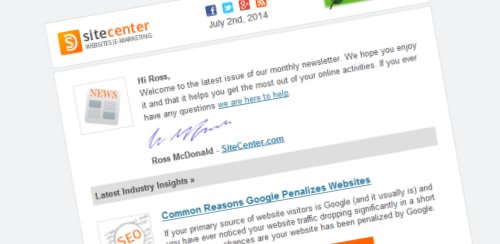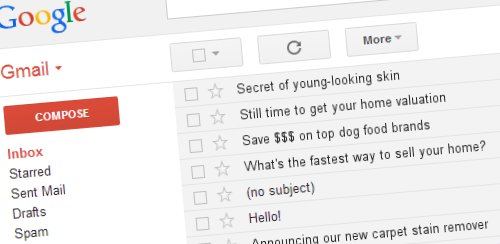
Email marketing is a cheap way of marketing your organization or it's products or services, with the only costs involving setting up your website to allow visitors to subscribe, having the email "creative" produced and possibly the use of third-party software to actually send the emails. A well-made website, however, could have all of these features built-in, with the only cost therefore involving the initial set up. Effective email marketing will result in a higher proportion of your website visitors being repeat-visitors, meaning that your website will experience more growth in visitor numbers, and ultimately more sales or inquiries.
Email Marketing Basics
Let's assume that your website features a way for you to attain the email addresses of your website visitors (see our Guide to Making Your Website Sell More Effectively for more information). Once you have a mailing list, it is important that you not only follow the laws relating to email marketing in the territory in which you live, but that you earn and keep the trust of your recipients. This means allowing your subscribers to easily unsubscribe or update their information, and sending just the right amount of emails to subscribers. As we will see, this may vary from subscriber to subscriber, and how many emails each are happy to receive will depend on the kinds of emails you are sending.
Personalized Email Marketing
Too many websites fail to exploit the full power of email marketing by only sending a standard email once a week or once a month to everyone on it's mailing list. While this is a good place to start, it neither takes advantage of the power to personalize that well-made websites should have, nor takes into account specific events. For a start, every email you send should address the recipient by their first or full name. Here are some common examples of personalized email services that websites can offer:
- Receive a website newsletter that is customized to specific topics that interest the recipient
- Receive an email notification when there is a new blog entry published
- Receive an email notification when a blog comment or forum post is replied to
- Receive an email notification when a new property is added to a real estate website that matches specific search criteria
- Receive an email notification when a specific event occurs, such as a drop in share price
- Receive an email notification when a new person is added to a dating website that matches specific search criteria
- Receive an email notification when a specific product is on sale
Taking Email Marketing Further
These services are good, and are probably the best way of accomplishing certain objectives. However, the capabilities of websites in this modern age are endless, and who's to say that a product should be on sale to everyone? Consider a scenario where a website member regularly makes a purchase of product A once a month for six months and then stops buying from you for three months. Your website could automatically identify this and send a 10% discount on those products only to that recipient. Here are some other scenarios involving advanced email marketing:
- A website visitor registers on your website, adds products to their shopping cart and then fails to check-out. 24 hours later your website automatically sends them a 10% discount code to encourage them to make their purchase, or send them a personalized email that encourages them to telephone you should they have any questions about the product they almost purchased.
- A website visitor regularly purchases product A and product B from your website. Your website automatically identifies this and includes a personalized discount for products C and D, which are related, in your website newsletter.
- Your website newsletter usually has the subject line of one of the products or articles featured in it. Your website automatically identifies that some recipients are more likely to read the newsletter if it has a subject line closely related to topic A. The next time you send your newsletter, your website therefore automatically selects the subject line for each recipient that means the email is more likely to be read.
Email Marketing Frequency
Nobody wants to be bombarded with emails after signing up for a newsletter or specific notifications. But there are cases when sending frequent emails can both be welcomed by the recipient, and extremely profitable for the website sending them. According to Experian Marketing Services, retailers began embracing the concept of same-day second emails in the fourth quarter of 2014 by, for example, sending an email with further reductions as a follow-up to an email sent earlier in the day. According to the data, these second mailings resulted in more transactions and a higher revenue per email sent than the first email. Of course this is one of those scenarios where your website's systems have to operate intelligently - in this case it would be very important to only send emails to those who did not act on the first email.
Conclusion
As we have seen, tailoring an email marketing plan to your own website only takes some imagination. While it might cost you some money to have such ideas integrated so that your website performs these tasks automatically, the potential return from increased engagement and increased sales can be enormous.
Last updated: 24th April, 2015


